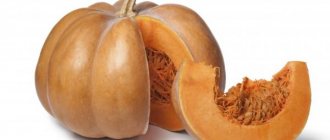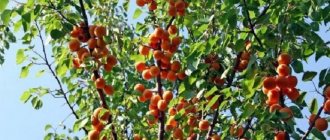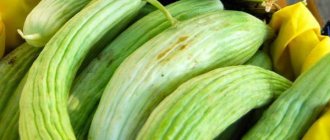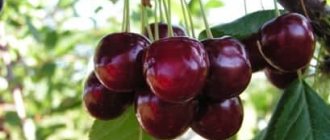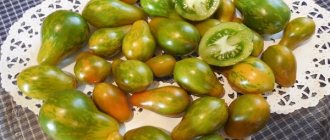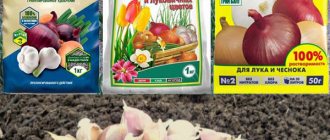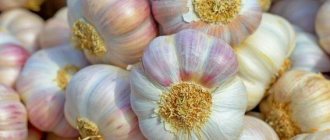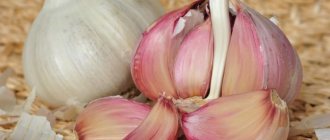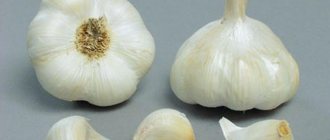In gardens and orchards, perhaps, there is no vegetable more wonderful than the vegetable that bears the name of the main character in the novels of the 19th century French writer Ponson do Terraia - Rocambole. Like its namesake, the rocambole vegetable is also something of an adventurer.
While collecting data on this crafty garlic, I encountered a certain paradox: there is no consensus on its name. In each country it is called differently, even in the names used in our country you can get confused.
Every gardener is convinced that he is the one who grows rocambola ; each one describes a different plant.
Elephant garlic. Rockambole
History of origin, distribution and interesting facts
In Europe, hybrid varieties of garlic of Dutch selection have become widespread; the seed packets indicate: “Garlic Elephant Garlic.” And in translation “Garlic” is “garlic”, a plant of the species Allium sativum, i.e. This is just a hybrid garlic Elephant, which summer residents call rocambole because of its size.
In the USA, rocambole is among the classification of garlics, which are divided into shooting (like Rocambole) and non-shooting.
There is nothing about rockamball in our Wikipedia. In the world we find the following entry:
“The sand leek (Allium scorodoprasum), also known as rocambole and Korean pickled-peel garlic, is a Eurasian species of wild onion with a native range extending across much of Europe, Middle East, and Korea. The species should not be confused with rocambole garlic, which is A. sativum var. ophioscorodon."
which translates roughly like this:
Sand leek (Allium scorodoprasum), also known as rocambole and Korean pickled garlic, is a Eurasian species of wild onion with a native range that extends to much of Europe, the Middle East, and Korea. The species should not be confused with rocambole garlic, which is A. sativum var.ophioscorodon.
In the “Great Encyclopedia of Vegetable Gardening” by Sh.G. Bekseev (St. Petersburg: “Dilya”, 1999), about Allium scorodopmsum L., it is said that it has a different name:
“Rocambole, or skoroda. In the wild, it is widespread throughout Europe, from Central to Northern (Denmark, southern Sweden and Finland), as well as in Asia Minor, on the islands of the Aegean Sea. Widely used in Chinese cooking and for pickling. Hair onion is close to garlic in many ways. It is cultivated in small areas in the western regions of the European part of our country and more widely in Western Europe and China."
In the Encyclopedic Dictionary of Brockhaus and Efron, in the article about Luke, we find the following description:
“garlic, chenek (Polish), Hiopu (Georgian), skhtur (Armenian) - the stem is half leafy, the leaves are flat, the bulb contains many small bulbs, which are used as food. Wild in Central Asia, in the Altai countries. A. Scorodoprasum L. - rocambole is a difference from the previous one.”
This vegetable is very interesting! The hybrid of onion and garlic, rocambole, has many names:
- On the Iberian Peninsula - it is a Spanish onion ;
- North Africa knows it under the name Egyptian garlic ;
- In America, Korea, China - it is elephant garlic ;
- In some countries - elephant onion or elephant onion-garlic ;
- In Russia, onions or garlic called rocambole have been known since the 19th century, but gardeners use the name hair onion.
Rocambole is a herbaceous perennial. It has a tall, dense peduncle up to 120 cm and long leaves (up to 60 cm), the number of which is up to 9. The Spanish onion throws out an arrow with a very beautiful purple flower. Here lies the first surprise of our adventurer: he is sterile. Rocambole has neither nigella seeds like onions, nor bulbous seeds inherent in garlic.
What does a rocambole onion look like:
This is the kind of giant you can grow
You might be interested to know:
- The secret of Rockambole's reproduction is hidden underground, where the adult fruit is formed. It is a head of garlic of impressive size: 6-10 cm in diameter and weighing 200-400 g. For comparison: a large fruit of ordinary garlic weighs on average 120-150 g, and a good bulb weighs 220-240 g.
- Large representatives of giant elephant garlic weigh up to 500-600 g.
- Rocambole seed material is another surprise of the culture. The next year, the children planted in the soil grow into single-pronged bulbs weighing from 40-50 g, that is, in the second year of the growing season the plant behaves like an onion.
- In the third year, giant garlic heads with cloves weighing up to 80 g .
- If the summer was cold, then the single-toothed Rocambole simply grows to large sizes (up to 100 g), and division into segments occurs in the 4th year. Thus, the growing season of Rocambole is 3-4 years .
- Planting material can be: children, single-toothed bulbs, cloves.
- Emigrants from Europe brought rockambole to America. Today, Peru produces 35% of the world's rocambole crop.
- In the USA, in the town of Gilroy, an annual food festival is held, the main ingredient of the dishes is rocambole. Guests of the holiday will be treated to dozens of field kitchens with the best chefs in the states.
Babies, one-toothed bulb and ripe head
How to grow Rocambole garlic?
You can grow Rocambole garlic from children
You can grow Rocambole garlic from babies (aerial bulbs) that grow on the lower part of the plant or from the cloves of the head. True, the first option will require longer preparatory work.
To begin with, garlic fry (babies) are collected from the roots. They are planted in spring or before winter (as a rule, the variety germinates in either option). In one year, the fry grows a tooth the size of a chicken egg or more, looking like an onion. And only if you plant it again next year, it will produce half a kilogram of garlic, divided into individual cloves.
It is important to note that two-year-old garlic, divided into cloves, and one-year-old garlic, a single tooth, obtained during the first planting, can also be eaten. That is why most summer residents do not complicate their work and eat them immediately after the first year of cultivation.
Before planting cloves or bulbs, they are soaked in a solution of potassium permanganate. Cloves and annual bulbs are always planted with the husk, but it is important to clean the bulbs or at least make a gap in the husk, in which case the germination rate of 60% will increase to 90-95%.
What is rocambole and its beneficial properties
Onions and garlic are species of the same genus - alliums. Rocambole onion is their relative, a variety. And no matter what we call it, the beneficial properties of rockambole cannot be taken away. It has a pleasant, unobtrusive taste. Having similarities with onions - it is not so bitter. Being related to garlic, it is not so sharp.
- After eating, this vegetable does not leave a specific garlic smell in the mouth, which is why many people refuse garlic.
- It will replace garlic in Asian dishes and onions in Russian dishes. It can easily replace onions and garlic in kharcho soup, fried potatoes, goulash, pizza, since it inherited the high iron content, vitamins A and C from onions, and allicin from garlic.
- This “adventurer” will change the understanding of the most common recipes. It adds a special flavor to salads and goes well with apples.
- The bulbs can be used as a seasoning, grilled or pickled.
On a note ! Young rocambole leaves are suitable for food use: they are similar to leek leaves and are consumed fresh, pickled or frozen. Rocambole arrows can be fried - their taste is similar to mushrooms, or pickled - we get the taste of capers.
Rocambol is used in folk medicine.
- Having phytoncides, it has antibacterial, antiviral properties, improves immunity, and is a good prophylactic against seasonal colds.
- Onion garlic is used for cardiovascular diseases; it reduces the level of “bad” cholesterol in the blood.
- In moderate doses, it is beneficial for the gastrointestinal tract, relieves toothache and treats stomatitis.
- Being a natural antiseptic, it relieves inflammation and promotes the healing of wounds on the skin.
Harm from onion-garlic can only be caused by excessive consumption. It can cause irritation of the mucous membranes. Not recommended for gastritis, ulcers, chronic kidney disease.
Young rocambole bulb
Onions with garlic flavor
Rockambol has several names. It is called onion garlic, hair onion, Egyptian onion, Spanish garlic, garden wild garlic.
Rocambole garlic combines the properties of two vegetables. This applies to both its appearance and taste. Two-year-old heads resemble large garlic and can reach a weight of 300 g. In the first year after planting the cloves, the root crop looks more like an onion and is not divided into cloves.
The flowers of the plant resemble purple balls, exactly the same inflorescences appear on onions. The above-ground part of onion garlic resembles a powerful leek.
Reference! Rocambole was originally a wild plant. Therefore, it can be found not only in gardens and vegetable gardens, but also in meadows and clearings.
Photo of rockambole:
Origin history and interesting facts
It is believed that the birthplace of rocambole is Central Asia. There it has been actively used for several hundred years for preparing fish and meat dishes. In the 18th century, it began to be actively cultivated in Mediterranean countries, the North Caucasus and Europe. The first mention of the hair bow in Russia appeared in 1877. But this vegetable is still considered exotic in our country.
Interesting! The ancient Egyptians attributed magical properties and divine origin to all plants of the onion genus. Rocambole was widely used by this great civilization during its heyday.
Varieties of onion garlic
Rocambole has long been appreciated by agricultural technicians. Russian breeders have also developed new varieties of this crop. Domestic varieties of onion garlic are distinguished by the fact that they can be planted even in the coldest regions.
Rocambole varieties:
- Elephant rockambole. On average, the bulb reaches 200 g. One root vegetable can contain up to 7 cloves.
- Janissary . The weight of the root crop is up to 100 g.
- Pearl . One head of garlic weighs 50 g. The taste is sharper than previous options.
All varieties presented are resistant to frost. They are excellent for growing in the central regions of Russia. Classic rocambola is more heat-loving, but reaches large sizes.
Features of the hair bow
Rocambole has the qualities of both onions and garlic. At the same time, it differs from these cultures.
Features of rockambole:
- big size;
- less pungent taste and less pronounced smell than garlic;
- onion-garlic aroma;
- the ground part looks like leeks, and tastes like garlic.
- reproduces by bulblets formed at the base of the heads.
Characteristics of the vegetable
To understand whether rocambole is worth growing, it's worth familiarizing yourself with its impressive characteristics.
Description of Rocambole Garlic:
| Options | Indicators |
| Root vegetable | Large. It can reach 200-300 g in size. In some cases, the heads can grow up to 400 g. There are from 5 to 7 cloves in one head. The taste is garlic-onion, soft. When cut, the flesh is beige in color. |
| Aboveground part | The stem is powerful and thick, reaching a height of 80 cm. The light green leaves are long (up to 60 cm) and wide. They have a garlicky taste and smell. Up to 9 leaves are formed on one plant. Onion garlic throws out arrows 1 m high with small lilac flowers collected in a large ball. |
| Reproduction | The inflorescences do not produce seeds. The culture reproduces by bulbs formed at the base of the head. On average, one rocambole head grows from 10 to 15 bulbs, each of which weighs 2-4 g. The bulbs are covered with a dense shell. |
| Landing dates | Rocambole can be planted in spring or winter. In the first year, the children produce a large onion, not divided into cloves. In the second year, it continues into slices, taking the shape of a head of garlic. |
Root composition
Onion garlic contains proteins, carbohydrates, allicin, germanium, magnesium, manganese, potassium, selenium, calcium, zinc, sodium, sulfides, vitamins A, B, PP, E and C, iron, phytoncides, carotene, and essential oils.
The calorie content of 100 g of onion and garlic is 149 kcal. This amount of root vegetable accounts for 6.4 g of protein, 31 g of carbohydrates, 0.5 g of fat.
Hair onion has choleretic, antimicrobial, antiviral, immunomodulatory, vasodilating, blood thinning and anthelmintic effects. By consuming rocambola, you can cleanse your body of toxins and improve digestion.
Chemical composition and calorie content
The advantage of rocambole is the taste and nutritional qualities that combine the properties of onions and garlic. It contains vitamins A , C , iron , like onions, and allicin , like garlic.
The disadvantage of rocambole is its short shelf life - 4-6 months.
The chemical composition is presented in the table:
| Vitamins | Contains, on average | Minerals | Contains, on average |
| RR | 0.7 mg | calcium | 181 mg |
| IN 1 | 0.2 mg | magnesium | 25mg |
| AT 2 | 0.11 mg | sodium | 17 mg |
| AT 5 | 0.6 mg | potassium | 401 mg |
| AT 9 | 3 mcg | iron | 1.7 mg |
| WITH | 31.2 mg | zinc | 1.16 mg |
| E | 0.08 mg | copper | 299 mcg |
| TO | 1.7 mcg | manganese | 1.672 mg |
| Kholin | 23.2 mg | selenium | 14.2 mcg |
Nutritional value of rockambole:
- Calories , kcal: 149
- Proteins , g: 6.4
- Fats , g: 0.5
- Carbohydrates , g: 31.0
Advantages of the variety
Benefits of rockambol:
- large heads;
- a large number of useful microelements in the composition;
- despite its similarity to garlic, it has a milder taste and aroma;
- easy to care for;
- unpretentious to grow;
- successfully reproduces vegetatively.
Varieties and varieties
Gardeners grow many different varieties and hybrids. Only one variety, “coiffure onion” (Allium scorodoprasum L.), is included in the state register of breeding achievements that are approved for use today, but in practice other varieties are also used.
- Variety "Pearl"
In the register since 2006, the patent holder is the State Scientific Research Institute of Breeding and Seed Production of Vegetable Crops, according to the characteristics - a spicy variety, a horticultural crop. Bred specifically for Siberia.
The variety is mid-season, produces an arrow, has a light green leaf with a faint waxy coating, 45-60 cm long, 3-4 cm wide. The bulb is large, rounded-flat, the color of the covering scales is white, the flesh is yellowish.
The mass of the bulb is approximately 50 g, in the bulb there are 4-6 cloves weighing 12 g each. Under the covering scales, from 3 to 5 children weighing up to 1.5 g are formed.
The taste is sharp, the yield is 1.9 kg/sq. m, frost-resistant variety.
This variety cannot be found in mass sales. The bulbs of this variety are not half a kilo, like elephant garlic, common in the USA and Europe.
- White Elephant hybrid is a product of selection by Belarusian specialists. Not included in the register of the Republic of Belarus. But it has good qualities: a large onion, up to 150-200g. Does not give flower arrows. Resistant to cold weather and fusarium, suitable for regions with short summers.
- Variety "Janichar" - released in 2021. It has a very large onion – up to 0.5 kg, and immunity to viral and fungal diseases. But it does not tolerate cold weather.
The best imported varieties include:
- Red Rocambole - 8-10 large cloves per bulb, grows better in high humidity conditions than other varieties. Large uniform bulbs, strong, spicy taste.
- Ukrainian Rocambole - medium-sized bulbs with 8-9 segments. Tolerant to weather conditions, resistant to diseases. It has a full flavored taste, spicy aroma. Disadvantage: short shelf life.
- Garlic Montana Giant garlic is a product of Italian selection, characterized by large cloves. There are an average of 5-7 of them in one head. The diameter of the head is 6 cm. The shell is white and pink, easily separated from the pulp. The taste is sharp and pleasant. The aroma is strong, garlicky. The variety is great for cooking.
Hybrid variety “Garlic Montana Giant”
Variety "Pearl"
When purchasing seed material, you need to consult with the manufacturer of the product to find out the characteristics of a particular variety or hybrid.
Farmer reviews
In our country, rockambole is still poorly distributed. Moreover, everyone who tried to grow this vegetable was satisfied with the result.
Belova Irina, Samara: “For several years now I have been growing rocambola instead of garlic. There is no more fuss with it, and it tastes better. It is softer and does not leave a characteristic smell in the mouth, but the beneficial properties are the same. I really like that the heads and teeth are huge.”
Chernousov Roma, Kursk: “I really liked the Egyptian onion. Excellent taste and size of heads. I didn’t encounter any difficulties in growing.”
Growing in open ground
On the Internet, they approach growing rocambola like growing garlic, but in agricultural technology they don’t even use the word rocambola.
But this is fundamentally wrong. Having decided to grow garlic onions, it is important to understand that you are growing leeks, not garlic, or you get garlic leeks, so their agricultural technology is a little different.
The main differences between growing garlic onions and regular garlic:
- Garlic onions are very fond of nitrogen; they can be grown using rotted manure from the first year of application.
- garlic onions love water in large quantities. It needs to be watered more often and more abundantly than garlic.
Rocambole in open ground
Like all onions, rockambole feels great in open ground conditions. The cultivation technology is something between garlic and onions.
With the exception of some hybrids that can tolerate shade, all rocamboles like light, warm areas. When growing, it is important that the soil for planting is loose, the soil is moderately moist, and without stagnant water. Onions do not grow in lowlands.
The best predecessors of rocambole in the garden are considered to be rapeseed or alfalfa, like green manure. Garlic onions grow well in the garden after zucchini, cucumbers, cabbage or legumes.
Under no circumstances should you plant a plant after onions, garlic or potatoes.
Planting in spring and before winter
Rocambole onion is grown as a spring and winter crop.
Larger bulbs are obtained from plants planted before winter. A good rocambole harvest depends on the selection of planting material. So, for winter planting, cold-resistant varieties are used, and for spring planting, heat-loving varieties are used.
Onion and garlic Rocambole food use
The use of Rocambole onion-garlic in food is not limited to salads. Greens can be fried. The cloves are eaten raw or added to seasonings for poultry and meat dishes. Elephant garlic is used in sauces, hot dishes and vegetable dishes. The addition of Egyptian onions is responsible for the piquancy and aroma of the prepared soup or pasta.
To prepare a vegetable salad, take Rocambole arrows, 2 tomatoes and a cucumber. Add bell pepper along with dill. For refueling you will need a st. l. Dijon mustard, pumpkin seed oil. Add salt to taste.
Onion-garlic Rocambole is an exotic plant in the garden, liked by summer residents for its taste properties, low maintenance requirements during cultivation and productivity. In addition, the product benefits the human body.
Optimal planting dates
In areas with a temperate climate, winter planting of garlic onions (rocambole) is practiced. Here you need to choose the optimal timing. They occur 2-3 weeks earlier than the first frosts (not frosts!). The garlic chives will have enough time to take root but not begin to sprout. When frost sets in, it will go through a period of vernalization, and in the spring it will be one of the first plants to sprout. The shoots are very similar to leeks and are a valuable vitamin product.
Rocambole shoots
In spring, onion garlic is planted as early as possible - even before the soil warms up. The plant is very capricious, so planting it late in the spring will result in a one-toothed bulb. This does not matter for cooking, but it is not suitable for planting material.
Spring planting of giant garlic
Selecting a location, preparing the soil and beds
For planting rocambola onion-garlic, light, warm areas with a southern orientation are chosen.
Before planting rocambole, you should clear the beds of predecessors, grass and weeds, dig up an area 20 cm deep, and level the soil.
It will grow on any soil, but if you want to have good results, you need to choose a site with good drainage, well-fertilized soil with rotted manure (25-40 kg per 1 sq.m.).
Rocambole loves fertilized soil, but does not tolerate fresh manure.
On heavy soils you need to make raised beds.
The rules of agricultural technology for rockambole require soil with neutral acidity within 6-7 pH . If the indicators are higher, the soil is alkalized with dolomite flour or lime.
Selection and preparation of planting material
The preparation of planting material depends on the choice we have made: to plant children of a mature bulb, single-toothed bulbs or segments of mature bulbs.
On a note ! Rocambole planting material must be renewed every three years - constant cultivation with cloves leads to degeneration. From this we get the conclusion that children need to be planted .
Kids . The baby rocambole does not lose its germination capacity for about three seasons if stored at a temperature not exceeding +8 in a dry room. Children in the second or third year of storage have better germination than freshly harvested ones. When preparing for planting, children are required to be scarified. Without doing this procedure, we will get long-term, unfriendly shoots, since the baby has very dense, often double, scales. Scarification - mechanical damage to the scale - is carried out very carefully, cutting off the top of the baby. Due to the labor-intensive nature of this process, you can scarify rocambole babies by briefly exposing them to contrasting temperatures: alternately lowering the bag with the babies into hot and cold water for one second.
Types of planting material: children, cloves, single-claw bulbs
On one of the sites, Tatyana Veklenko shared a seedling method for growing rocambole from children. Let’s say right away - the process is not for the lazy - so the choice is yours, because the author assures that he achieves one hundred percent germination, and this is important, considering the price of planting material.
Single teeth . Whole bulbs, without damage or spots, are selected for planting. The material is sorted by caliber for rational distribution across the beds and cleaned of excess husks. Two days before the intended planting, they are soaked in a weak solution of potassium permanganate.
Onion slices . Well-ripened, dried bulbs should be selected, without mechanical damage, obvious signs of degeneration and disease. Material from an onion where at least one slice is rotten or covered with mold will be unsuitable - we discard such material. When sorting planting material, you should pay attention to the main signs of degeneration: the segments are radically different in size; fused together; with a double top - we also discard such heads completely.
Pay attention to the bottom of the onion - it should be free of cracks and damage. Rocambole bulbs purchased in a supermarket may be unsuitable for growing, since to extend their shelf life, their bottoms are treated (burnt) in a special way. Separating the cloves from the bulb is done immediately before planting - to avoid drying out the bottom. We do this carefully to prevent damage to the integumentary scales. Practicing gardeners say that the harvest obtained from a bare slice is no worse, but cannot be stored for a long time.
We divide the selected material by caliber and plant segments of different sizes in separate beds, then they will grow more evenly and the harvest will be uniform.
If you are not sure about the planting material, then you need to disinfect it. This procedure will not provide a complete guarantee, but will reduce the risk of developing diseases and pest damage to rocambola several times.
The simplest method of disinfection is with a slightly pink solution of potassium permanganate , leaving the rocambole planting material for 15-20 minutes - it has complex disinfecting properties. But others can also be used:
- saline solution : 2 tablespoons of table salt per 10 liters of water - soak the prepared planting material for a day;
- alkaline-ash solution : pour 0.5 kg of sifted wood ash with three liters of boiling water, leave for 20 minutes on low heat, leave until completely cooled; Decant the liquid, dilute it with 2 parts of cold boiled water and soak the material for 1-2 hours.
- Copper sulfate solution : 2 teaspoons per 1 liter of water - soak the rocambola for 15 minutes - for fungal diseases;
After disinfection, the planting material is not washed, but dried and immediately planted in the ground.
Interest in rocambole is growing - many farmers and private farms want to grow it. Prices are also increasing, and everyone wants to get the largest caliber planting material inexpensively. Therefore, when choosing, you may come across sellers who, under the guise of rocambole, sell Suvorov, Aflatunsky, Gigantsky, some varieties of Anzursky onion, or even large cloves of ordinary garlic of the porcelain subtype. We don't think the sellers have any malicious intent. Rather, it happens due to their ignorance or ignorance.
Planting rockambole babies
Many vegetable growers order seeds from online stores. It is better to do this on the websites of planting material manufacturers, this way you will protect yourself from counterfeits.
When starting to grow garlic onions, you must understand that this crop is expensive and selected planting material cannot be cheap. When purchasing material, pay attention to the caliber of the teeth or check with the seller if it is not indicated on the store’s website. of 35-50 g will be optimal for spring planting 20-35 g for winter planting .
On a note! From a clove less than 20 g, when planted in spring, you can only get a larger single clove, suitable for further reproduction.
Growing rocambole requires patience from the vegetable grower, which is not enough.
When planting in spring, garlic cloves must be kept in a cold (1-2 degrees Celsius) place for 2-3 weeks. This will have a positive impact on proper growth.
Before planting, the children and bulbs need to be exposed to sunlight for greening. This way they will germinate faster.
Planting scheme
The planting scheme and care of rocambole onion-garlic plants depend on what material we use.
- Children . Sowing is done on a well-leveled area according to a 10x10 cm pattern. Before winter sowing, be sure to mulch with a layer of sawdust or straw of more than 3 cm.
- Single teeth . Rocambole is planted in rows with an interval of 30-40 cm and at a distance of 20 cm in the row. Planting depth is three bulb sizes.
- Teeth . Plant onion-garlic in rows with an interval of 30 cm and in a row - 15-20 cm with the bottom down to a depth of 3-5 cm. To avoid damage to the planting material, do not put pressure on the cloves. Cover with soil and compost.
What are the difficulties of care?
Rocambole garlic is very heavy, it is worth all the effort that is spent on it during planting and care, so you should not neglect any of the points described below.
- In cold regions, garlic crops should be covered with film or agrofibre to avoid freezing in the cold winter or spring.
- The crop needs to be watered regularly; it loves water, so once every 2-3 days in the hot summer it is necessary to water the crops abundantly.
- Loosening the soil and removing weeds is carried out regularly after watering.
- If the leaves begin to lose color and droop, this means that the crop lacks nutrients. Feeding is carried out with solutions of chicken manure, mullein, and sometimes minerals are used.
Care
Rocambole is not considered a fancy plant, but with proper cultivation and care it greatly pleases its owners.
To form full-fledged bulbs from pre-winter planting, during the growth of green mass in the spring and before the formation of bulbs, regular watering, loosening and fertilizing are necessary.
For spring planting of onion-garlic, the soil must be prepared in the fall: dug deep, humus, compost and wood ash added. Here the same scheme: water - loosen - fertilize.
Rockambol. Features of cultivation
Watering and fertilizing
During the growth period, rocambole, like most vegetable crops, needs constant care. Missing watering affects the harvest. On light soils, watering is done twice a week; on heavy soils, you can do it once.
To prevent the soil from drying out, it needs to be mulched.
If the soil under the rocambole is well fertilized with organic fertilizers, then fertilizing may not be required.
- First feeding . For winter garlic, we do it at the end of winter or early spring, in the snow. Add ammonium nitrate at a dose of 1 tablespoon per 1 square meter. We feed spring-planted garlic with nitrogen fertilizers when shoots emerge.
- The second feeding is the same for winter and spring rockambole. Produced when 3-4 leaves appear. Dilute 1 cup of chicken manure or mullein in 10 liters of water and mix with 1 tablespoon of urea.
- The third feeding for onion-garlic at both planting dates. 2-3 weeks after the first fertilizing, we fertilize the soil with a solution of nitrophoska (2 tablespoons per 10 liters of water) at the rate of a bucket of water per square meter.
- the last fertilizing of the rocambole when the bulbs begin to form. To do this, take 1 tablespoon of potassium sulfate and double superphosphate per 10 liters of water and spill the beds at the rate of a bucket of water per 2 square meters.
On a note ! We combine all fertilizing with watering.
Watering is necessary if we want to get healthy bulbs and children. With sufficient watering, an increase in the mass of the bulbs and the normal formation of cloves is ensured. To ensure that the soil does not dry out and the bulbous rhizomes develop well, we cover the row spacing with mulch.
Ripe onion with babies
Weeding, loosening and mulching
From the appearance of the first shoots and before harvesting, rocambole beds require care. We carry out the first loosening of winter garlic as soon as the soil dries. For spring-planted garlic, when the first shoots appear. Carefully loosen the row spacing and the soil between the sprouts.
We do loosening after each watering.
Then twice a week during the growing season we inspect the beds and do weeding to remove all the weeds that make their way through the mulch. Only rocambole should grow in the onion-garlic bed. Every time we check the plants for diseases or pest infestation. Remove prematurely yellowed or diseased plants.
We cover the winter planting beds with mulch in the fall after planting. Mulch thickness of 3 cm or more. The harsher the winter, the thicker it is: up to 10-15 cm. Mulch is necessary to insulate the soil in winter, suppress weeds and protect against drying out. For mulch, sawdust, straw, fallen leaves, and synthetic materials are used, which are sold in abundance in seed stores. Summer-planted onions are mulched with straw or synthetic material.
Rocambole inflorescences
Removing an arrow
Rockambole releases an arrow. It is very long with a beautiful pink inflorescence. There are no seeds in the inflorescence, so to increase the yield, the arrow is removed. We practice removing the arrow as soon as it appears from the tube. To do this, we begin to gently pull the end of the arrow, wrapping it around our hand.
Interesting ! From the arrows you can make a dish that tastes like fried honey mushrooms; to do this, you need to wash them, chop them to 2-3 cm in length and fry them in butter.
Some gardeners share the secret that when they break out the peduncle of a rocambole, they do not get the effect of enlarging the bulb itself. This procedure led to an increase in the number of children, which of course leads to an increase in the amount of planting material, but increases the time for harvesting. Many children, breaking away from the mother's bulb, remain in the ground and sprout like a weedy plant.
You decide for yourself whether to remove the arrow or not.
Disease and pest control
Disease and pest control is a very important point in caring for all cultivated plants. Rocambole is also sick. To fight diseases, you need to know them in person.
- Rust . Appears on plant leaves in the form of small light brown bubbles. For control, a sulfur compound is used when spraying or watering.
- White rot . The disease manifests itself when rocambole is continuously grown in one place. Infectious microbes are found in the soil and on plants, the progressive disease can be seen by the growth of cotton fungi with black spots. All affected rocambola must be destroyed. The soil needs to be disinfected, and then do not plant garlic in this place for 15 years.
- Fusarium . The most common onion disease. It appears from the tips of the leaves, which turn yellow, then turn brown, gradually descending towards the bulb. In very hot conditions, infected plants wilt and the bulbs become watery. Onions that do not show symptoms of the disease, but are infected, will begin to rot during storage.
- Thrips and mites . Insects that attack all bulbous plants. They stick to the plant and drink the juice, which leads to withering and death. Wounds on the leaves will become entry points for other contagious diseases. To combat thrips and mites, it is necessary to dry the mulch in which they develop, use adhesive tape or a pheromone trap.
- Onion fly . Lays eggs at the base of leaves. The developing larvae crawl down the plant trunk to the bulb and begin to feed on it. The leaves of the affected plant turn yellow, wither and fall off. Chemical means of protection are used in the fight.
Garlic four-legged mite
Nematode
- Nematode . Like the fly, the larvae feed on the onion. Rocambole is brought into the same condition as white rot or onion fly. Some plants disappear from April to June. Then the whole bed may die. To combat - chemical methods of protection. For prevention - preliminary soil preparation. Crop rotation is ineffective because the nematode affects almost all plants.
How to plant Rocambole
Rocambole is an easy crop to grow. Onion garlic can be planted in any region of our country. It easily takes root in open ground and does not require special care.
Soil preparation
To get a high-quality harvest of garlic onions, you need to properly prepare the soil for planting. Rules for preparing the soil for planting rocambole:
- For onion-garlic, a plot of land on which legumes, zucchini, cabbage, radish, rapeseed, cucumbers or rye were previously grown is suitable.
- It is better to plant onion garlic in a well-lit, not darkened place.
- At least two months before planting, it is necessary to dig up the soil and enrich it with humus, ash and manure.
Preparation of planting material
In order for all planting material to germinate, it must be stored correctly. Before planting, it is prepared, preventing infection of the rocambole with plant diseases and accelerating the appearance of the first shoots:
- Daughter bulbs are sorted by size. The larger they are, the larger the onion garlic heads will be.
- Store the bulbs for planting in a dry, dark place at a temperature of 25 degrees.
- The bulbous planting material is freed from the hard shell. This will make it easier for him to germinate. Such measures are not carried out with teeth.
- Before planting, onion garlic is placed in a place with a temperature of 0 degrees. After keeping it there for 21 days, the planting material is taken out into the sun. This will allow the rockambola to quickly adapt to new conditions in the garden.
- Before planting in the ground, the bulbs are treated with a weak solution of potassium permanganate. Planting material should be soaked in it for 12 hours.
Important! Planting and caring for rocambole is similar to cultivating garlic. However, this culture is distinguished by its unpretentiousness and frost resistance.
Planting onion garlic
Onion garlic can be planted at different times of the year. The basic rules for placing planting material in the ground do not depend on this:
- Dig trenches 25 cm wide. Moisten the soil. The distance between rows can vary between 10-20 cm.
- Place the rocambole bulbs at a distance of 20 cm from each other.
- Fill the trenches with soil without compacting it.
The timing of planting determines how quickly the rocambole will produce a harvest. You can plant onion garlic in spring, autumn and winter.
In winter
According to gardeners, it is winter onion garlic that produces the largest harvest. Rocambole can be planted in this way in any region of our country.
At least 2 months before work you need to prepare the beds. Garlic is planted 14 days before the first frost. During this time, the planting material will have time to take root, but will not germinate.
The depth of the trench should be 30 cm. Place compost at the bottom of the recess. The thickness of this layer should be within 7 cm.
Mulching when planting garlic in winter is mandatory. This will protect it from freezing. Hay, dry leaves or compost are used as mulch.
For autumn
If you plant onion garlic in the fall, then the next year they will turn into large heads, divided into cloves. In this case, planting material is placed in the soil in September.
When planting in autumn, trenches are dug 10 cm deep. After planting, it is advisable to mulch the onions.
in spring
Work begins as soon as it becomes possible to dig up the soil. Onion garlic is not afraid of frost and germinates at a temperature of 5 degrees.
When planting in spring, the depth of the trenches should be 10 cm. Before planting, it must be well moistened. It is not necessary to mulch the beds.
Cultivation care
Rules for caring for rockambola:
- Watering. Hair onion is a moisture-loving plant. It needs to be watered abundantly and regularly, not allowing the soil to dry out. You need to use settled water for these purposes.
- Loosening. You need to loosen the soil after every watering and rain. This will prevent the formation of an earthen crust that interferes with normal air exchange.
- Feeding. Be sure to feed the garlic twice a season. The first fertilizing with nitrogenous fertilizers is carried out during the period of appearance of the first shoots. The second time the crop is fertilized with phosphorus-potassium compounds during the formation of the bulbs.
What difficulties might you encounter?
In order for the rockambole to grow healthy and please you with large heads, monitor the condition: any changes are signs that the culture is missing something.
The quality of the onion-garlic harvest largely depends on the composition of the soil. If the greens have become withered and yellowed ahead of time, it is necessary to add additional fertilizing. Use special fertilizers for onions and garlic.
The conditions required for growing hair onions are ideal for weeds. Therefore, weeding beds with rocambola is mandatory.
The arrows with inflorescences that the plant produces are beautiful, but useless. They do not contain viable seeds, but take nutrients from root vegetables. Therefore they need to be removed.
What diseases and pests are hair bows susceptible to?
There are not many diseases and pests in the world that can affect garlic. But you will still have to protect the crop from some of them:
- Fusarium . It is expressed in the form of rotting of the bottom and roots of onion garlic. Caused by a fungus. The reasons for the appearance are considered to be improper care of plants and damage to root crops by insects. Garlic and onions should not be planted in beds affected by this disease for several years.
- Root mite . In most cases, it affects already harvested onion garlic, causing it to dry out. To prevent its occurrence, dry the crop well and promptly remove rotten and damaged heads.
- Onion fly. This pest penetrates the bulb through the bottom and eats it from the inside. To prevent its occurrence, sprinkle the beds with a mixture of tobacco, ash and black pepper once a week.
Application of a hybrid
We will not go into the basics of botany. But let’s decide for ourselves.
A variety is a group of plants with identical characteristics selected as a result of breeding. The seeds of such plants produce offspring with the characteristics of the mother.
Hybrid (F1) is the result crossing several varieties to improve color, taste, shape, resistance to diseases and pests. But their seeds are no longer capable of reproduction.
- Natural rocambole (garlic onion) is a subspecies of the Allium family. We have already talked about this.
- Modern rocambole is a hybrid of onion and garlic, onion and natural rocambole, other variations are also possible.
Modern breeding uses a variety of methods to breed hybrids, including genetic modification. So on the website of a seed store I found: “Cypriot rocambole is a hybrid of leek and garlic with a larger proportion of garlic.”
You can distinguish a variety from a hybrid by the inscription on the seed package - F1 will always be present there.
Onion garlic propagation
The crop is grown by pups that appear from below on a two-year-old plant. Heads planted in April will be able to produce a small bulb by autumn. Although Rocambole likes the cold, prolonged frosts interfere with its development and therefore temperatures of -15 °C will kill the seedlings. This must be taken into account when calculating the landing time.
Onion garlic babies
Harvest and storage
When growing rocambole, timely harvesting is important. It depends on the natural zone and the time (winter or spring) of planting, but you need to focus on the appearance of the plant. Drying of the lower leaves with proper care is the first evidence that the onion garlic has arrived at the time of ripeness.
The ripening period begins 2-4 weeks after cutting the shoots. To be more convincing, you can dig up one onion and look. It is impossible to keep rocambole in the ground - its bulbs grow as long as there are green leaves - there is a possibility of the outer skin of the heads cracking and the children falling out, getting lost in the ground. If kept in the ground for a long time, the head cracks into teeth; such a crop cannot be stored for long periods of time.
Rocambole vintage
Comparison of garlic bulbs and rocambola
The bulbs are carefully dug up, clods of earth are shaken off into a sieve, and sifted to separate the detached children. The bulbs can be left to dry in the garden bed, shaded from direct sunlight, but it is better to put them under a canopy and dry for 2-3 weeks. Then we look through the bulbs and, making sure that they are dry, cut off the roots and stem.
For rocambola, cut the stems 3-5 cm above the bulbs, tie them, then place them in a dark, well-ventilated place. In this way, rocambola can be stored for 6-12 months with natural air ventilation, humidity no more than 65-70% and a temperature of 2-10 degrees.
Peeled, trimmed, ready to store bulbs
Blanks are made from rockambole. I. Brizhan from the village of Chelbasskaya, Krasnodar Territory, shared the recipes on one of the sites.
- Divide the rockambole into cloves, add hot water (50-60 degrees), leave for a day. Then put into jars, pour hot marinade and roll up. Store in a cool place.
- Peel the rocambole, rinse, fill half-liter jars to the brim. Pour boiling water, add vinegar, sugar, salt. Place in boiling water for 5 minutes to sterilize. Roll up. For 1 jar: 1 tablespoon of 9% vinegar, 1 tablespoon of sugar and 1 teaspoon of salt.
- Divide the washed, peeled young rocambole heads into cloves, put them in a jar, and fill them with a solution (6 tablespoons of salt per 1 liter of water). Cover with a lid and place in a cool, dark place for 30 days. Then drain the water, rinse the teeth with water and add marinade (for 2.5 cups of water - 1.5 cups of 9% vinegar, 1 tablespoon of sugar, 1 tablespoon of salt). Close the jar and place in a cool place. After a month, the rockambole is ready. To obtain a beautiful color for the teeth, water can be replaced with a solution of 1 part water and 1.5 parts red beet juice.
There are many recipes using rocambole garlic, it won’t be difficult for you to find them
Bulbs of the third year of growing season
How to plant Rocambole
Complementing the topic of what garlic onion is, you can indicate the following. Rocambole is a large vegetable. For it to be like this, it needs to be planted, following certain rules. Each plant should be planted at a sufficient distance from each other: the greater the gap between crops and the wider the row, the more light falls and the faster the garlic grows. The optimal distance between rows, as well as between seedlings, is 30 cm.
The best planting depth is 9 cm. A lower location is impractical: seedlings may appear late. In addition, the bulbs form poorly.
Planted garlic
When to plant onion garlic Rocambole
The most suitable time for planting onion garlic of the Rocambole variety is late autumn. It can be planted in spring, but winter bulbs will be larger in size.
Note! It requires low temperatures to take root. In Russia, the plant can be cultivated in the spring from early April to May.
Planting material
Planting material should be prepared several months before planting. Before spring planting, it is necessary to leave the heads in the refrigerator for 30 days. In this case, children's teeth are used.
Calibration, that is, separating small and medium-sized slices from large ones, is a mandatory step. The day before, the material should be disinfected using potassium permanganate (in a ratio of 1:0.5).
In the first year, the children will turn into one-toothed ones, in the second they will reach a larger size, and in the third they will grow to a standard size.
Tillage
The top soil layer must be loosened to a depth of no more than 30 cm. The soil should not be dry.
Selecting a location and preparing the bed
The ideal place for Rocambole garlic to grow quickly is an open bed, well lit by the sun. Rocambole will grow much better where zucchini and cucumbers, legumes, rapeseed, rye and radish were previously located.
Preparation of the bed includes careful digging and application of fertilizing several months before the procedure (rotted compost, ash or complex nitrogenous fertilizers).
Next, you should bury the cloves in the ground 6 cm from the top of the slice. Large specimens need to be planted deeper and less often among themselves, small ones - closer to the surface of the earth and more often.
Preparing the beds
Diseases and pests
Diseases that affect Rocambole onions include:
- root rot - this disease affects the bottom of the head. Occurs during rainy periods or with excessive and frequent watering;
- rotting begins when the plant is infected by the onion fly;
- under poor storage conditions and air humidity, root vegetables can rot; for prevention, onions are periodically sorted and dried.
See also
Planting and growing garlic from bulbs in open ground, care and harvesting
Read
Important! If the onion is affected by rot, it is not recommended to plant root crops in this bed for 3-4 years.
Among the pests are:
- Root mite. The parasite destroys the crop after it is harvested. The mite, penetrating through the bottom, causes early drying of the onion pulp. Sorting and removing affected dried root crops will help prevent loss. They are primarily consumed as food.
- Onion fly. This insect penetrates the bulb and completely eats away the inside. For prevention, it is recommended to alternate rows of onions and carrots; their tops repel flies.
Important! For prevention, experienced gardeners scatter ground hot pepper between the rows. Insects leave such a bed, and the harvest remains intact.
How to care for culture
Proper planting allows the plant to develop and grow, but to increase productivity and create optimal and comfortable conditions for the seedlings, you will need to perform a full range of plant care work.
Watering, weeding, loosening the soil
Plants require constant and sufficient watering in the first few weeks after planting and for 30-40 days after the first shoots appear. But it is not recommended to be overly zealous with watering. The soil in the garden should always be moist and loose. During the period of active development and growth, the onion hybrid will need to be watered after 3-4 days, 10 liters per 1 m2. Further watering is carried out when the soil in the garden dries out.
Important! Experienced gardeners advise loosening the soil between rows and rows more often. 2 weedings replace one watering. To maintain a constant level of humidity, add a layer of mulch after each watering and loosening.
Fertilizer
You will need to feed the hybrid onion variety at least 3 times:
- In early spring before the first shoots begin to appear. This is the time for nitrogen fertilization, it promotes rapid growth of foliage and tuber development. Ammonium nitrate granules are evenly scattered over the surface of the row at the rate of 20 g of the substance per 1 m2 of bed.
- The phase of active development of root crops. Prepare a solution per 10 liters of water: add 200-300 g of fresh chicken manure, 20 g of urea. Mix the ingredients and water the plants at the rate of 3 liters per 1 m2.
- A few weeks later, during the formation of the root crop, the plants are re-fertilized to increase its size. Water with 5 liters of fertilizer for each m2 of the prepared composition - 200-300 g of sifted wood ash are stirred in 10 liters of water.
Important! If the onion foliage begins to turn painfully pale, and the plant itself looks weakened, it means that the bushes do not have enough nitrogen fertilizer.
How to clean and store garlic onions
Winter Rocambole must be harvested in late July - early August, spring - in mid-September. To tell if the bulbs are ripe, look at the foliage: if the tops are yellowed and the bottoms are dry, it's time to start cleaning.
The main thing is not to delay the process, otherwise the husks will come off the bulbs and they will go deeper into the ground. But it will not be possible to preserve onions without peeling.
- We take the onion-garlic out of the ground, shake off the soil and dry it a little.
- Then dry it in a well-ventilated area.
- When it is completely dry, cut off the roots and tops, or just the roots, and the tops will help weave onion braids.
- We store the onions in a dry place, scattered in boxes or bags, at 20-25 degrees.
So, you have learned what Rocambole or onion-garlic is, the cultivation technology of which is possible through spring or winter planting. Grow this unusual plant, which contains all the benefits of onions and garlic, and improve your health!
